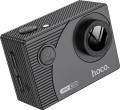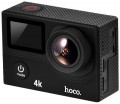HD (720p)
The ability of the camera to record HD video (720p).
The official HD specification provides a resolution of 1280x720. However, in action cameras, there may be resolutions slightly different from this parameter, for example, 1080x720 or 1440x960. Anyway, HD is the most modest of today's high-definition standards, which, nevertheless, provides a fairly clear and detailed image.
Another important parameter given in this paragraph is the frame rate. The higher it is, the smoother the movement in the frame will be, and the details in dynamic scenes will be visible clearly. Technically,
30 fps or even less is enough for video, but
60 fps is considered the perfect value — at this frame rate, motion blur becomes almost imperceptible and at the same time the size of the captured files remains within reasonable limits. However, there are cameras on the market with higher frame rates at HD resolutions —
100 fps,
120 fps,
200 fps and even
240 fps. This speed is usually used for recording slow-motion video, but such a possibility needs to be specified separately.
Quad HD
The ability of the camera to shoot QuadHD video.
This standard includes an extensive set of resolutions — from 1440 to 3456 pixels horizontally and from 1440 to 2160 pixels vertically, with almost two dozen intermediate options. It is a rather specific transitional option between the relatively inexpensive FullHD 1080p and the demanding UltraHD 4K, allowing you to shoot higher resolution video than 1080p without significantly increasing the cost of equipment. Note that pure QuadHD resolutions are rare in TVs and monitors, but modern technologies make it possible to comfortably watch videos of this format on any high-resolution screen.
Another important parameter given in this paragraph is the frame rate. The higher it is, the smoother the movement in the frame will be, and the details in dynamic scenes will be visible clearly. For example, a filming speed of
25 fps or
30 fps approximates the standard frame rate in film and television; such an image is quite viewable, but fast-moving objects in the frame will look blurry. With an increase in speed to
60 fps, this effect becomes almost imperceptible. The highest QuadHD frame rate found in modern action cameras is
120 fps; this frequency is used when shooting slow-motion video (as well as models with a frequency of
100 fps) because at a n
...ormal playback speed, 60 fps is enough.Ultra HD (4K)
The ability of the camera to shoot Ultra HD 4K video.
This format covers several resolutions in which the horizontal frame size is approximately 4K pixels. The most popular in action cameras is 3840x2160 (twice the FullHD frame on each side), but there are other options — for example, 3840x1920, corresponding to an aspect ratio of 2:1. In general, 4K is a kind of successor to Full HD: among HD standards that surpass Full HD, UltraHD is the most popular, in particular, many advanced TVs are produced with 3840x2160 screens. On the other hand, this format is quite demanding in terms of processing power and memory, so it is relatively rare in action cameras, mainly among premium models.
Another important parameter given in this paragraph is the frame rate. The higher it is, the smoother the movement in the frame will be, and the details in dynamic scenes will be visible clearly. However, in UltraHD mode, most modern action cameras produce a very low frame rate — most often
30 fps, and in some models
24 fps or even
15 fps. This video is quite viewable, but fast movement in the frame may look blurry. There are cameras capable of shooting UltraHD at a solid speed of
60 fps — the blurring effect during such shooting is almost imperceptible. However, such a model cost is high.
Field of view
For models with several lenses, as a rule, this parameter is indicated for each lens.
Most often (unless otherwise indicated), the specifications indicate the field of view by the diagonal of the frame; in some
ultra-wide-angle lenses it can exceed 180°. A special case is made up of lenses for which a 360° view is declared: this means that the optics cover the entire hemisphere in front of it. Such lenses are found in panoramic and 360-degree cameras (see “Product type”).
In general, the field of view primarily determines what area of the scene is being captured into the frame. Accordingly, the wider it is, the more space the camera captures, and the lower the likelihood that something that is happening will be off-screen. On the other hand, it is worth considering that a strong increase in the field of view leads to distortions of the “picture”, especially at the edges, as well as, to a decrease in the size of visible objects and a decrease in detail. Detailed recommendations regarding choosing a camera based on this parameter can be found in special sources.
Digital stabilization
The presence of a digital (electronic) stabilization system in the camera design.
Any stabilization is intended to compensate for small juddering of the image that occurs due to the instability of the hold in the hands, vibrations from the motor or road roughness (when used in transport), etc.
Digital stabilization is carried out as follows: a reserve area is allocated along the edges of the sensor, which under normal conditions does not participate in the formation of the final image. If the device is being shaken, the camera electronics select certain parts of the image from the reserve and build the image in such a way that in the end, it remains stable.
Compared to other methods of stabilization, digital systems are extremely simple and reliable. Moreover, they are inexpensive and have almost no effect on the weight, dimensions, and price of the camera. At the same time, with this method of stabilization, the effective area of the image sensor is reduced, which can adversely affect the image quality and the amount of noise on it.
Megapixels
The number of megapixels in the action camera sensor, in other words, the resolution of this sensor(1 megapixel is 1 million photosensitive points).
There is an opinion that the higher the resolution, the better the image quality. It is true from the point of view that manufacturers are trying to install high-resolution sensors in advanced cameras. At the same time, there are no strict dependencies here, and from the technical point of view, the number of megapixels determines only the maximum image resolution that can be captured using this sensor. The quality of this picture will depend both on several features of the sensor itself (size, type, special design solutions), and the specs of the camera. So when choosing, you should focus not so much on the resolution of the image sensor, but on the general class of the camera and reviews with examples of footage.
Front screen
The presence in the camera of a screen mounted on the front panel, next to the lens. Other displays may not be present at all; in such cases, the diagonal, resolution and other parameters are given for
the front screen.
It is worth noting that most often the simplest black-and-white displays are installed on the front panel, suitable only for text and basic graphic information. However, even on such a screen, you can display a wide variety of service data: the current mode of operation (photo, video, standby), the resolution used, the shooting time, the amount of free space on the drive, etc. But more advanced displays are not used as front displays: a full-colour screen is needed only for taking a selfie, and for this you can use a
remote display with a remote control(see "Control") or a smartphone connected to the camera.
Connection
—
GPS module. Built-in satellite navigation module that allows you to determine the current coordinates of the device. Options for using data from GPS can be different: geotagging footage, recording travelled routes, determining the speed of movement, or even full-fledged navigation on the map.
—
Wi-Fi module. The Wi-Fi wireless module in action cameras can be used in different formats: in some models, it is responsible for connecting to the Internet, in others it is for communicating with a smartphone or other gadget, in others both options are available at once. Anyway, the main use of this connection is to transfer footage to an external device or to the Internet (including broadcasting in the online streaming format, see “Filming capabilities”). In addition, more specific functions can be provided, for example, using a smartphone as an external viewfinder and remote control. Specific features of the use of Wi-Fi in each case should be clarified separately.
—
Bluetooth. Direct wireless communication technology for exchanging information between two electronic devices. In action cameras, it is most often used to connect remote controls, selfie sticks and smartphones, which can also act as a remote control. Unlike the Wi-Fi module, it consumes battery power more economically, but at the same time, the range of wireless communication is reduced to 10 m
...etres.
— NFC chip. NFC is a wireless communication technology over short distances (up to 10 cm). In action cameras, this technology is mainly used as an auxiliary one, to facilitate connection with a smartphone or other gadget via Wi-Fi or Bluetooth. If such a gadget is also equipped with NFC, just bring the camera to it and confirm the connection — it's easier than fiddling with the settings.
— USB-C. A relatively new type of USB interface that uses a miniature double-sided connector, slightly larger than microUSB. Most often used for similar purposes — as a universal connector through which you can charge the battery and connect the camera to a computer (for copying photos and videos, updating software, etc.). P.). At the same time, USB-C provides a higher data transfer rate than microUSB, supports more power supply, and also has a more convenient plug. Occasionally, there are more specific ways to use this interface — for example, direct connection to a smartphone or tablet that has a USB-C port.
— HDMI output. HDMI is a digital interface specially designed for high-definition video and multi-channel audio. With this output, you can connect the camera to a TV, monitor or other device as an external player and play the footage directly. The convenience of HDMI is that almost all modern video equipment with support for HD standards is equipped with such inputs.
Note that the cameras can be equipped with a smaller version of the connector — miniHDMI or microHDMI; however, finding an adapter cable is usually not a problem, it can even be supplied in the kit.
— Microphone connection. Almost any modern action camera has a built-in microphone that allows you to record sound. However, the quality of its sound is often quite low. Thus, many models can connect an external microphone — you can fix it, for example, on the helmet strap and record the comments of the athlete in the process of movement. Note that different types of connectors can be used for such a connection. As a result, the specific connector type and supported accessories depend on the action camera model, and some devices are only compatible with branded microphones.Max. memory card capacity
The largest memory card capacity supported by the camera model.
This limitation is due to two points. First, the larger the drive, the more computing power is required to use it. Secondly, each type of memory card has its maximum capacity. For example, the capacity of an SD HC card cannot exceed 32 GB, larger drives already belong to the SD XC standard, and if it is not supported, the maximum card capacity cannot exceed 32 GB.
It is strongly not recommended to exceed the maximum allowable capacity: even if the card is recognized by the device, its normal operation is not guaranteed.

